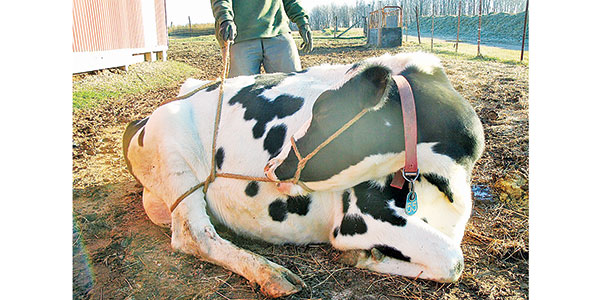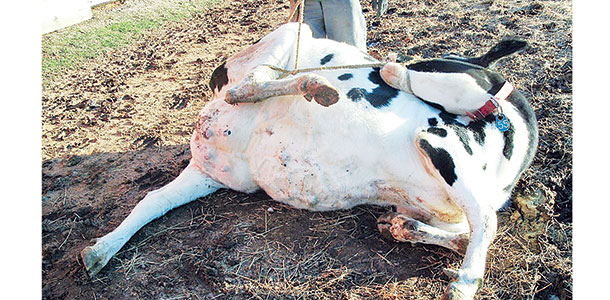“Down cows are one of the unfortunate realities of dairy production,” according to Robert Leder, DVM, chairman of the Wisconsin Veterinary Medical Association’s Dairy Welfare Committee. “When a cow goes down, we need to set up some protocols: who is going to be responsible, when are we going to take care of it, what we are going to do and how we are going to do it,” he says.
Who?
When it comes to choosing the individuals on the dairy who will respond in a down cow situation, it is OK to be picky. Leder points out that not everyone is the right person for the job. The criteria comes down to identifying those who truly care about cows first, then empowering that team to handle the situations according to protocol.
“We want to identify, enable and involve the ‘cow’ people,” he says. “It’s not good enough to identify and involve them, and then not enable them.”
Enabling employees means trusting them to make decisions, not second-guessing them. A clear, consistent set of standard operating procedures (SOPs), established with the help of the herd veterinarian, defines expectations of how down cow situations are to be handled.
All employees should know what to do when downer situations occur. On some dairies, the chain of command may simply be to call the down cow team into action. Those trained individuals who have been given this responsibility may be the only ones allowed to move the cow, and they do so in accordance with the farm’s established procedures.
When?
Time is of the essence with a down cow; the longer she is down, the less chance she will ever rise again. In fact, research shows that when a cow lies on concrete in excess of six hours, pressure damage will occur to the hind leg on which she is lying.
“Down cows are an urgent situation,” Leder notes. Getting them moved off of hard concrete and onto a clean pack of straw or sand is an essential first step to recovery. This location should provide the two “F’s”: freedom and footing.
Cows need the freedom of adequate lunge space to rock forward and stand up, just as they do in a stall. Be sure there are no obstructions in front of them, including people. Also, remove any constraints, including halters.
Good footing means that the cow can dig into the surface with her rear legs. Lime or sand can be helpful in providing traction. Leder has had success with rolling cows onto a piece of snow fencing. Whether plastic or wooden, the slats give the cow extra grip. For this tactic to work, the fence must run beneath the chest of the cow as well so she holds it in place as she attempts to stand.
What?
Those responding to a down cow incident need to be able to quickly assess the situation. This includes a brief profile of the cow, such as her age, how long she has been fresh and history of lameness, as well as what was going on at the time she went down.
Perhaps she slipped while exiting the parlor, or maybe she just calved. These factors can help to identify the reasons why she may have gone down and appropriate treatments.
The location in which the cow goes down must be assessed as well. Was it in the maternity pen, holding area or alley? In a stall or on pasture? Is she endangered by other cows in this environment? Of course, cows seldom choose convenient places to go down.
That is why protocols should be specifically written and employees trained for getting cows out of sticky situations in a manner that is safe for both animals and people.
How?
Humane handling is key to moving down cows, and Leder reminds us that the method used should not directly or indirectly result in further injury. Dragging cows by the neck or legs can cause additional trauma, as well as lesions and damage to the cow’s skin – her first line of immune defense.
 “The skin is our largest immune system. When we have a compromised cow that is down, we don’t want to further damage it,” he states. “That’s why it is important to get cows onto a suitable surface to move them.”
“The skin is our largest immune system. When we have a compromised cow that is down, we don’t want to further damage it,” he states. “That’s why it is important to get cows onto a suitable surface to move them.”
“Suitable” surfaces don’t have to be fancy, but they do have to protect the cow. Options include rubber mats, wide belting, plywood and old stone boats. A scoop bucket on a tractor or skid steer can also be suitable as long as cows are rolled into the bucket – not scooped.
Moving a 1,500-pound cow onto a suitable surface may sound like a daunting task, but Leder suggests a method to make it much easier. “Bundle” the cow by placing a rope halter around her head and then tying the remaining rope to her exposed rear leg. Using the rope as the control, two people can roll the cow backward onto a surface or slide a surface under her body while she is rolled back.

Once the cow has been located to a recovery area, it is time to develop the diagnosis, prognosis and treatment plan. If the cow has been treated and does not stand within 12 hours, a veterinarian may need to assess the severity of her injury. Also, if the cow does not exhibit an appetite, her chances for recovery drop drastically.
Leder considers float tanks to be the “gold standard” in reviving down cows, but he warns against hip clamps.
“Hip clamps have limited usefulness,” he says, adding that they can cause significant bruising and pose danger to the cow. “I would rather see a cow left to creep around on good bedding and footing than for her to be lifted.”
For those cows that don’t respond to treatment and assistance, a tough call has to be made. “If she can’t stand within 24 or 48 hours after the initial treatment, we have to consider putting her down,” Leder adds.
Leder suggests keeping records of down cow incidents, including the “who, what, where, when and how” of the situation. This information can help to identify trends and underlying causes as well as provide teachable moments for employees. PD
PHOTOS
As shown here, bundling the cow allows her to be safely and easily rolled backward so that a suitable surface can be placed underneath her body. Photos courtesy of Bob Leder.

Peggy Coffeen
Editor
Progressive Dairyman






